#12: Up the Junction
Ed Jefferson is attempting to visit every Mews in Greater London. This week: Royal children's entertainers, British Imperialist street naming, and sexy paving slabs.
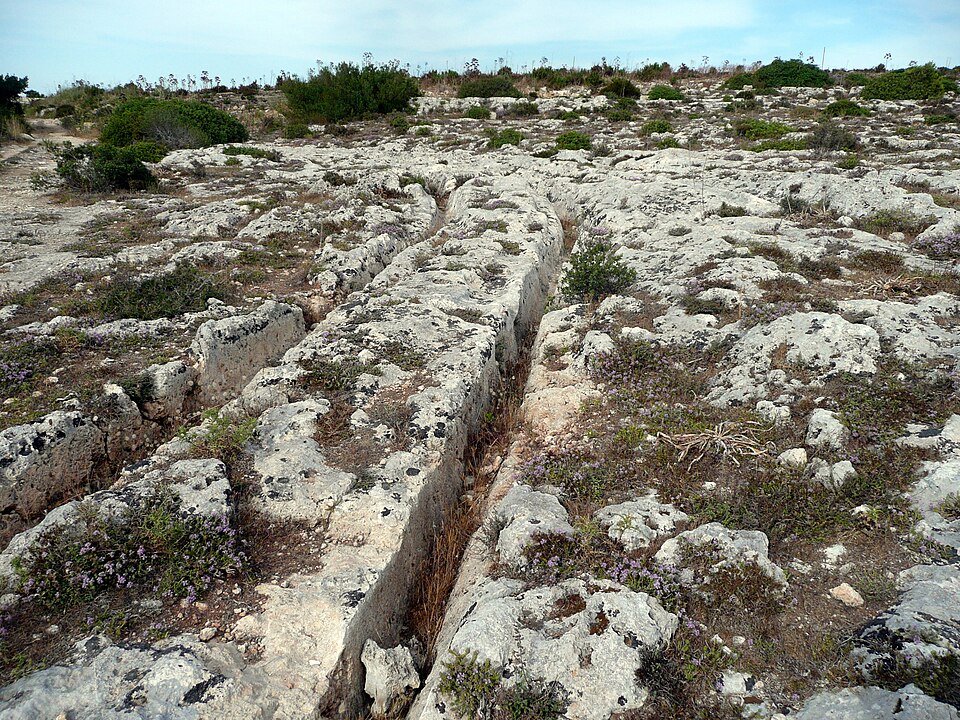
On glancing at my master map of Mewses the other day, it occurred to me that I have so far spent hardly any time south of the river, so I decided to head off for Battersea. First stop, Clapham Junction railway station.
To those unfamiliar with London’s geography, who I assume subscribe to this newsletter to learn about it in the most confusing way they possibly can, this makes more sense than it nominatively appears to, because Clapham Junction is actually in Battersea, rather than say, Clapham.
Why is Clapham Junction in Battersea? Well, the construction of the railway network in the 19th century involved lots of different railway companies, and originally it wasn’t much of a network at all. Companies would run their own lines and stations independently, even when that meant, as happened just down the line from where Clapham Junction is now, you got two completely separate stations essentially next door to each other. Eventually it dawned on the three rail companies operating in this part of South London that cooperation might be mutually beneficial, and they got together to build Clapham Junction at the most advantageous interchange point.
Oh right, you meant why is Clapham Junction in Battersea - well, there does not appear to be a 100% solid answer on this. It is probably not, as is occasionally suggested, because it was built by the junction trains use to get to Clapham - there doesn’t appear to have ever been a junction named that and a relatively small number of trains go in that direction from here anyway.
Another possibility is that the name derives from one of the separately run stations it replaced - Clapham Common, which has nothing to do with the tube station of the same name, wasn’t very close to Clapham Common1, and also definitely wasn’t in Clapham.
The generally accepted answer is that it was essentially a branding exercise, 19th century Battersea being more industrial and a lot less swanky than 19th century Clapham. This has driven a lot of moaning over the years from Battersea residents who considered the whole thing to be an act of snobbery; there are decades’ worth of local newspaper letters about this, including both business owners bemoaning that it’s hurting trade because no-one knows where they actually are, and residents complaining that business owners are deliberately pretending to be based somewhere else to sound more prestigious.
The 21st century saw the rise of the SW11tch Back to Battersea (SW11 being the area’s postcode) campaign, who, though they failed to get the name of the station changed2, did successfully lobby a local branch of Asda to stop telling people that it was in Clapham. Well done?
Is it really true that the name was down to pretensions of grandeur? A 1963 letter to the South Western Star newspaper claims that it was the fault of Tory members of the parish council, who in a meeting to decide on what to call it, apparently believed that Battersea Junction was "not a very distinguished name" and the Clapham Junction "rolls more easily off the tongue" - though as this letter was written more than a century after the supposed meeting and based on the recollections of the author’s father, who the hell knows.
Ultimately the whole issue has essentially been moot for as long as anyone still alive can remember, as like many other places in London, the station rapidly came to define the area - the answer to ‘Where is Clapham Junction?’ being, obviously: Clapham Junction.
Annoyingly, there’s one other claim sometimes made about Clapham Junction’s name that would be quite handy for me at this point - that it originally took the name of the railway bridge just to the west of the station. Sadly, given the connection between Mewses and birds of prey (see Mews Letter #2), the station has never been called Falcon Bridge.3 Anyway, Mewses:
The Mewses
#111 Cranleigh Mews, Wandsworth, SW11

A line of 14 railway arches housing a range of businesses - why not have your antique iron railings restored, then have them delivered by the zero emission cargo bike delivery services a few arches down? I’m sure they will be well up for the workout.
It’s the last survivor of a run of streets that were heavily bombed in the second world war, and were essentially written off in 1951, when the County of London Development Plan recommended they (along with the similarly damaged streets the other side of the railway line) become a park. Which obviously they did, but the clearances were incomplete as of the mid-1970s, perhaps because the council had used the area for temporary accommodation that then turned out to be not all that temporary when they couldn’t work out where else to put the people living there.
‘Fun’ fact: Cranleigh, the village the Mews is presumably named after, was for many years spelt as Cranley, but the Post Office made them change it because shit handwriting meant they kept sending people letters that were supposed to go to Crawley.
#112 Zulu Mews, Wandsworth, SW11
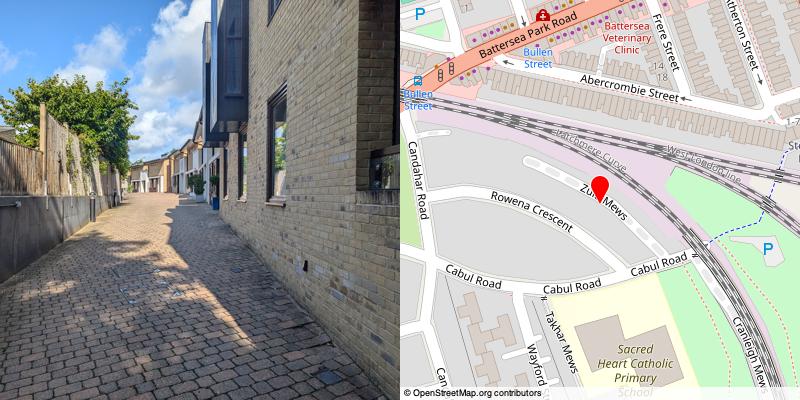
As it stands, the last street in the London A-Z, surely a gauntlet thrown down for any property developers looking for some easy PR from bad local news websites. Zygogenesis Lane? Zwiebacks Alley? ZZZ Mews?
In this instance the intention was not purely to game the A-Z - it’s actually a reference to the former name of Rowena Crescent. The streets here were originally developed 1879-81, and were named after the locations of various places where the British Empire had done some Military Glory - hence you get Cabul Road, Candahar Road (I don’t know why they spelled them with a C back then, other than to be annoying).
Around the same time the Empire had also won the Anglo-Zulu War. The street now called Rowena Crescent was at first therefore Zulu Crescent - actually a sort of pun because the “crescent formation” was apparently a Zulu tactic.
This turned out to be a bad idea - by 1883 residents were campaigning to have it changed. The exact nature of their complaint is unclear - certainly, despite the nominal victory, the Anglo-Zulu war was, on several counts, a bit of a shitshow, Michael Caine films notwithstanding, so perhaps the association wasn’t welcome.
My (unfounded) suspicion is it is a bit more basic than that, and was just the result of good old-fashioned bullying of the “Ha ha, you live where? [racist inference goes here]” variety. The Metropolitan Board of Works rejected the preferred Church Crescent as an alternative because there were too many of them in London already, so they settled for Rowena Crescent instead
When a new housing development was planned on the land behind the road in the 2010s, someone got clever, so we have Zulu Mews. Whether it is in fact clever to keep naming roads (effectively) in honour of dubious 19th colonial enterprises is another question, but hey ho, I suppose you can always say it’s now intended to honour the Zulu people instead.
Anyway, it’s possible naming streets after violent conflicts had some karmic consequences, as the original property developer, Alfred Heaver, was later shot to death by his brother in law.
#113 Takhar Mews, Wandsworth, SW11
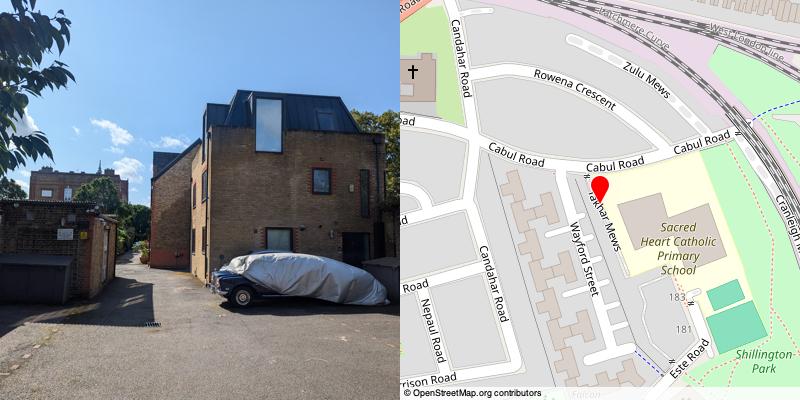
Turn of the century residential development, Takhar being a province of Afghanistan, thus vaguely following the theme of the existing road names. Though surely should be called Tachur to maintain the bad spelling.
#114 Ambrose Mews, Wandsworth, SW11

The site of the Wandsworth & Clapham Union Dispensary & Relief station, part of the local workhouse system, which once offered various kinds of “assistance” to the poor. Less workhouse-based forms of help having subsequently been conceived meant that the once rather smart building was long since derelict by the time of WW2, when the Germans saved everyone a job by bombing it to bits.
It was redeveloped as the Mews towards the end of the 20th century - the original building’s North and South Lodges survive at the far end, having spent the intervening years flanking a yard used by (ironically) a demolition company serving clients who couldn’t rely on the help of the Luftwaffe.
#115 Crombie Mews, Wandsworth, SW11
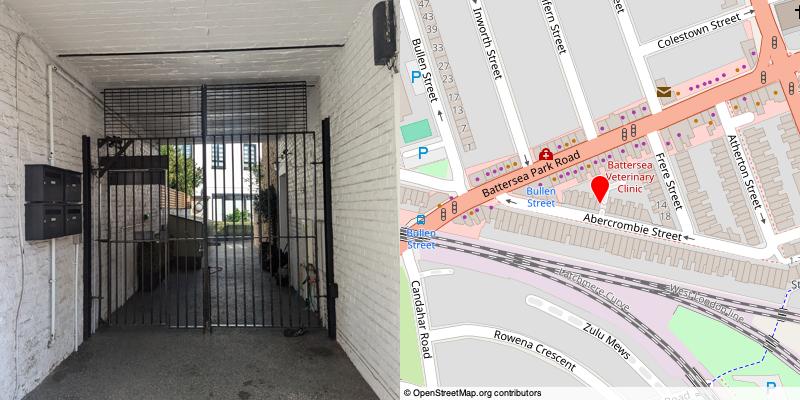
Confusingly, Battersea at one point had two Crombie Mewses - one here, serving Abercrombie Street (makes some kind of sense), and another serving a road called Rush Hill, which has since been renamed to the slightly more logical Rush Hill Mews. Given that they were built at approximately the same time, I am entirely prepared to believe that someone at the council got distracted and did this entirely by accident.
In the years since it stopped being used by horses, has had various occupants including (at one time) a business founded by Etonians that runs children’s parties for extremely minted children, e.g. those of the Royal family. It’s called “Sharky and George”, which is weird. Can you really just name your company after a fairly well-remembered (if you're the right age) kids’ cartoon without anyone minding? Weird. I'm gonna call mine “Defenders Of The Earth”. Hello children, who likes Mewses and sarcasm?
#116 Kersley Mews, Wandsworth, SW11
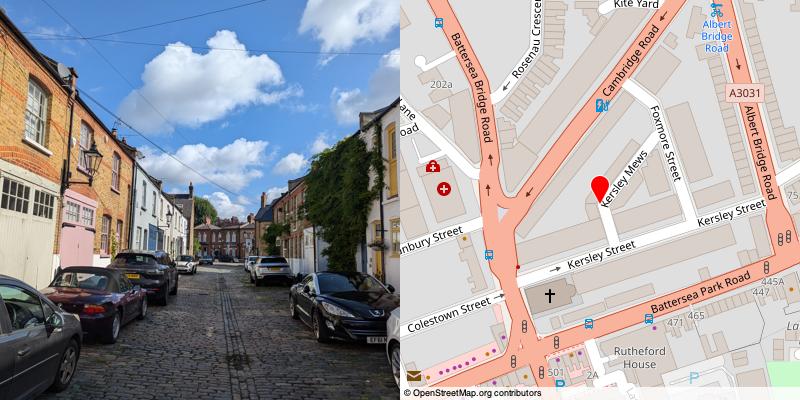
In 1953 a resident of this Mews wrote to a local newspaper to proclaim that it was outrageous that the council had spent £122 on wallets for councillors. Do my local councillors get free wallets? I certainly am going to be very cross if I find out they do.
This is a rare example of a Mews round here that survives in something approximating its original form, albeit inhabited by people who can afford £2 million quid for a house rather than say, horses. At least one of them has a swimming pool in the basement. Why don’t I have a swimming pool in my basement? I blame those corrupt local councillors, more concerned with free wallets than giving me my swimming pool I reckon.
#117 Prince Albert Mews, Wandsworth, SW11

Infill development that was originally office space but has subsequently been converted into flats. The earliest Google Streetview images from 2008 show something that looks, if you squint, a bit like a sign indicating that there was a public footpath to a wood here, which makes very little sense.
Further investigation revealed that the sign was a gimmick signboard for one of the businesses that used to be based here - Holmes Wood, who are involved in wayfinding and placemaking, i.e. working out how to indicate to people where they are and how they can get to other places that might want to be from there using maps and signs and so on. Feels to me like quite a satisfying thing to do in an odd kind of way, maybe I’ll have a go at that in my next life.
#118 Patricesy Mews, Wandsworth, SW11
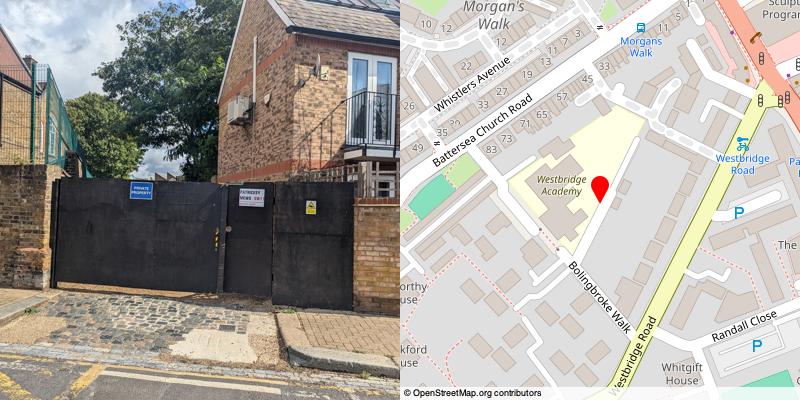
This appears to be a relatively new name for an alleyway that has existed since the 19th century. A name was presumably required as the owners of various houses on Westbridge Road have constructed new houses at the bottom of their gardens over the last decade or so, either to sell or to store their more annoying family members in.
Patricesy is what Battersea was called in the Domesday Book so well done to the owners there, but less well done on installing a very crappy looking gate across the bottom of the road that I’m slightly surprised they’ve got away given it looks to be in a Conservation Area. Anyway, as a top journalist I had a peer through one of the holes and can report that you aren’t missing much.
#119 Althorpe Mews, Wandsworth, SW11
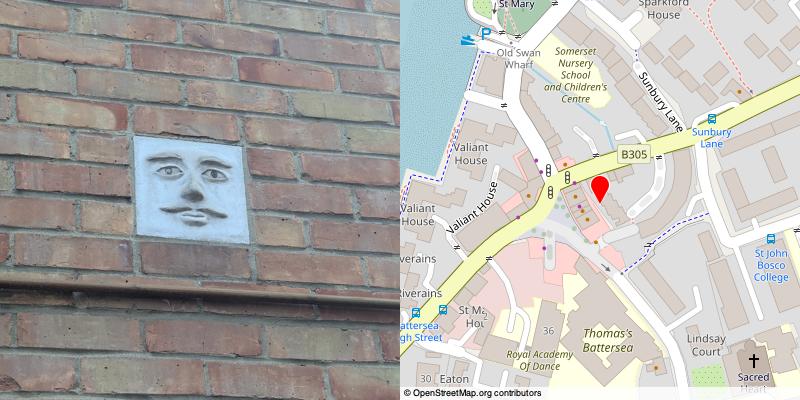
Former site of no less than the Royal Laundry (or part of it at least), in an era when Battersea was known for its steam laundries (the steam powering the laundry rather than cleaning the clothes directly).
The Mews is part of a 1970s council housing scheme and is used as sheltered accommodation. The best feature is the little faces set into the walls - the main bit of the estate round the corner has concrete portraits of (among others) Lord Nelson, Vanessa Redgrave and, er, Tommy Boyd, but I’m not clear whether these ones are also supposed to represent specific people.
I have just ruined them for myself by remembering that bit in that one Doctor Who episode about the guy whose girlfriend gets irreversibly turned into a face on a paving slab and the resulting dialogue: “We've even got a bit of a love life.” Good grief.
#120 Cotswold Mews, Wandsworth, SW11

Yet another old laundry site - for many years as the Cotswold Laundry, hence the name. Then used by Welsh firm Delyn to make packaging for e.g. Marks & Spencers, then converted again into offices in the 80s, before finally becoming housing in the 2000s. The penthouse, bizarrely, has its own Instagram account (there’s a hot tub next to the laundry’s surviving chimney), and it appears the owner ended up in court for headbutting a business partner. If only there was somewhere nearby he could have got to clean the blood out of his clothes, eh readers?
Mewses Visited So Far: 120/2380

It was far closer to Wandsworth Common, and was originally called Wandsworth - it was renamed when another station called Wandsworth was opened in, well, Wandsworth. To make matters even more confusing, another railway company then opened a station right next door to Clapham Common called New Wandsworth, so Clapham Junction at least eliminated as many problems as it created. ↩
The station has, as a token gesture, added a sign noting that it is ‘The Heart of Battersea’. ↩
Despite what quite a famous historian who has the same name as Spider-Man once tweeted. Podcast that mate. ↩
Add a comment: